|
|
|
Events & projects
- nre update soon
- http://www.mqviennafashionweek.com/index.php
From 23.9. to 27.9.09 MQVienna Fashion-Week takes place
You are wellcome to PARTYSANE stand 314 in"Freiraum"Quarter

- PARTYSANE cooperates with her new businesspartner: artfeld
She is speciallized on textile print art and colourmanagement.

PARTYSANE Fashion show at Textile Art Berlin, 20.6.09, 19h, Karl-von-Ossietzky Oberschule Berlin, Kreuzberg, Blücherstr.46
- Digital Print School
for professionals and artists: offer we classes in digital printing on textiles. From canvasprint to textile repeat,
customized for your requirements.
Application: info@partysane-fashion.com
- Wiesbaden Rathausexhibition fom 11.12.-14-12. open from 11am til 19pm with exclusive PARTYSANE- fashion and accessories.
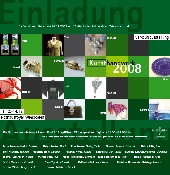
-
Fashion Week 2008 from 17th. to 20st. of july in Berlin
-
PARTYSANE and Designpool Berlin presents Fashion Show at Strandgut and Schowroom Unter den Linden 21, Berlin. www.frischberlin.com
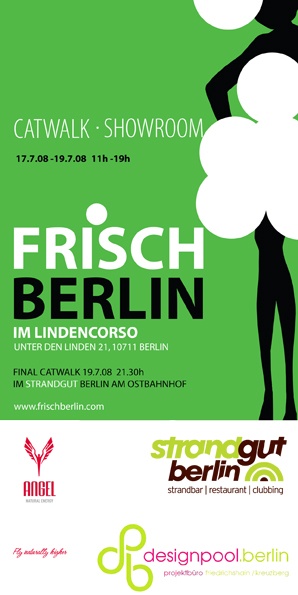
-
PARTYSANE exhibition in Berlin Wedding, 2GARAGE2 RELOADED, Koloniestrasse 10, 13357
opening 30.5.08, to 1.6.08
-
in springtime 2008 PARTYSANE and COLOR-WEB started a project about sustainable fashion. Soon you will find more information about it.
-
next fair with PARTYSANE
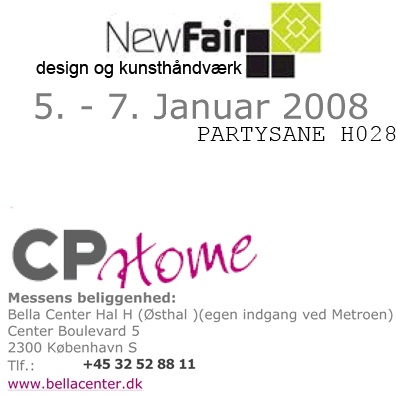
-
Invitation to Exhibition in Wiesbaden, 13.12.-16.12.07
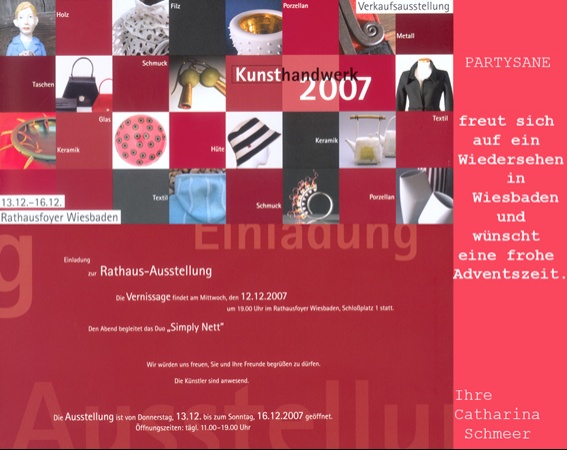
-
NEW offer: PARTY-design 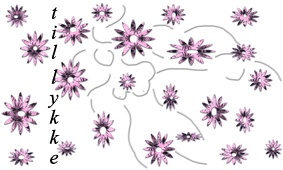
Did you already plan your next big party?
PARTYSANE supports now with indiviual designed table cloths, napkins, personal invitation cards and more for your guests.
Just bring your own ideas and get them develloped together with PARTYSANE. We are looking forward to getting in touch with you!
-
Danish Arts -and Crafts- market , 23.8.-25.8., Frue Plads, København www.kunsthaandvaerkermarkedet.dk 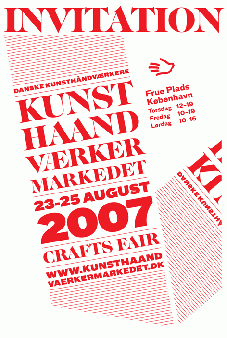 PARTYSANE´s "rabbit, caged in a dress" is a unique dress (size 40) which is to be found at markets stand no. 8 and the price is 2222kr. PARTYSANE´s "rabbit, caged in a dress" is a unique dress (size 40) which is to be found at markets stand no. 8 and the price is 2222kr.
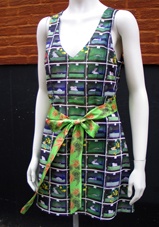
-
PARTYSANE exhibition at Højbjerg Library in Århus, from 6th of february until 7th of march07 www.hojbjergbibliotek.dk and www.aakb.dk
-
Design&Brugskunst fair , 6th.-8th. of January 2007, in Copenhagen, BellaCenter / Center Bulevard,2300KopenhagenS PARTYSANE exhibits new digital print designs in hall C, stand 012c www.bellacenter.dk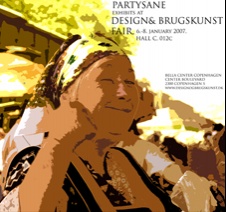
-
Next PARTYSANE exhibition takes place at Hanne Bertelsens workshop, sat., 2.12.06 from 12 to 17. in St. Paulsstrade 72, 1313Kopenhagen www.hannebertelsen.dk
-
Friday,1.12.06, from 19 to 23 starts Montre the month of Advent with Loungemusik and Christmas exhibition. There will be the chance to find the most beautifull gifts.
Friday,1.12.06, from 19 to 23 starts the month of Advent with Loungemusik and Christmas exhibition There will be the chance to find the most beautifull.
-
Lauritz.com presents from the 9.09 to the 10.09.06 the first time a virtual and real arts exhibition, called PASSIONSDAGENE with more than 120 artists, 100 arts and crafts people and 20 designers. The exhibition takes place in Copenhagen Vesterbro, in the faircenter Øksnehallen, (PARTYSANE is one of the exhibitors), www.lauritz.com -auction runns until end of september!
-
Montre celebrates 1years anniversary in Kopenhagen, Halmtorvet 19 saturday, the 19.08.06 from 14-18, www.montre.dk 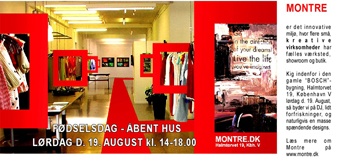
-
The FORMLANDMESSE in Jylland takes place from the 11.8. to the 14.8.06, the first time with a common stand of Danish Arts and Crafts people and with PARTYSANE. www.formland.com
-
"striber til stol og krop" 
The danish weaver and printers guild celebrates his 60 years anniversary with an exhibition in Copenhagens medieval tover Runde Tårn from the 18.6. to the 6.8.06, in Sønderborg Castle from the 13.8. until the 25.9.06 and from the 1.10. until the 12.11. o6 in Textilforum in Herning. See www.rundetaarn.dk
As one of 58 textile artists Catharina presents a cotton satin cloth (size 1,5mx3m) pritid with digital inkjet technique, called:Engel über Berlin.
-
Speach held at the International Textile confernce SCYTHIA 2006 in Cherson, Ukraine:
"The challenge of digital inkjet printing"
Dear colleagues, ladies and gentlemen,
I will talk today about the challenge of digital inkjet printing on fabrics.
Allow me first to introduce myself briefly. I will then try to give you an insight into textile digital printing techniques and applications. I will conclude my presentation with a few pictures from my work.
I was born in Germany and grew up as a tailor’s daughter. My mother had the amazing ability to transform old, outdated clothes into new fashionable creations. Today I am very thankful to her that I inherited this ability.
I studied textile design focusing on weaving and frame printing and I obtained the textile designer degree from the Saarland University of Technology (class of Oscar Holweck and Sofie Dawo). Later on I also finished the handcrafts teaching studies. After many years working as a teacher and using all textile techniques, I completed an apprenticeship and obtained a master craftsman diploma (the German Meisterbrief) in the textile professional tailoring.
In 2000 I opened my workshop and began creating new fashion by recycling old cloth and textiles. Since then my company PARTYSANE carries the slogan: “…valuable clothes have more than one life”. Unfortunately, I had to give up this working area after a while despite a good feedback and appraisal from customers, since it was unprofitable.
After moving to Denmark in 2002 I realised my dream of turning my photographical work into fashion. My pictures always had a kind of textile character. What fascinates me most about textiles is, on the one hand, the direct connectivity to the human culture throughout the history. On the other hand it is the technical development and improvement.
A few years ago I discovered for the first time an admiration for the huge digitally printed advertisement posters covering houses. I knew that these represented exactly my professional ideas for the future. I wanted to achieve this overwhelming effect also in my fashion and clothing. I searched for companies that would offer the necessary techniques to realise my ideas, and this is where I came across digital inkjet printing.
At that point in time it was still difficult to find somebody who would be able to print directly onto natural fibres since most of the methods at that time were used only for outdoor purposes in the advertising industry. Hardly any supplier would then guaranty for the quality of the colours. Neither could they again provide exactly the same colours half a year later. The printing process contains an extremely large number of variables that impact on colour repeatability such as for example temperature and air humidity.
The conversion of a traditional textile printing company into one using digital printing seemed like a commercial risk, and since the customers didn’t necessarily wish this change, there were little incentives for suppliers to introduce the digital printing.
Today, digital colour printing has matured considerably and the improvement is guaranteed through the constantly ongoing research and development in the area. Since recently the market also offers reasonable pigment ink colours additionally to the reactive ink colours that allow printing on untreated natural textile fibres.
In recent years the demand for digital inkjet printers for textile application is slowly but constantly rising (even though only 600 machines have been sold worldwide last year) (according to ….. at the conference Desinger meets Technology in sept.2005). Developments of inks for digital printing have partially evolved in response to the increasing demand for the ever-finer printing technology in micro- and nanometer scale.
Two years ago I had the opportunity to start cooperation with the Dutch company STORK who produces digital printers themselves. Enthusiastically, I decided to operate a digital printer myself. Since last summer I am experimenting with my MIMAKI TX. Despite the fact that one could already define this printer as an “old lady” considering the current technology, I am having great satisfaction with my machine regarding flexibility and manifold applicability. Starting with my digitally processed urban scenery photographs to the typical textile repeats, everything can be magnificently realised on cotton, silk, and even wool. The København Tekniske Skole students whom I teach in digital inkjet printing and who use my TEX-printer are enthusiastic to experiment and work on the realisation of the many ideas they have. Recently, the school invested in a new digital large format printer (MIMAKI JV4, 160cm width), which is more multifunctional and modern. It facilitates the school’s educational duties not only in the textile department but also satisfies the needs of the graphic department.
Slowly, the textile industry starts perceiving the advantages and profitability of the digital printing technique. Especially when dealing with small samples and editions up to around 1000 pieces, shifting to digital printing is worthwhile. Additionally, the demand for exclusive and custom production is growing rapidly. The customer increasingly wishes for individual clothing that underlines his/her personality.
The advantage and forward-looking of digital printing technique stems from its flexibility that allows for the rapid reproduction of unique samples, or in other words the mass production of individual clothes. On the other hand, the economical and environmental advantages of digital printing technique are very convincing. Among those are especially the economisation of costs for labour, transport and storage. It is the beneficial “production on demand” and the enormous saving of water and energy resources that convinces an increasing number of firms to shift their production. The fabric design becomes more efficient with the possibility of direct implementation of customer’s requests, and avoiding overproduction. Many firms still unashamedly exploit the cheap labour supply in the so-called “third world” countries to flood the industrial nations’ textile markets with mass-produced clothes. That part of the clothes (products) that is not sold is sent back and sold to the third world countries thereby destroying local markets.
Recently, I wrote an article for the Dutch textile magazine EUROSTITCH entitled “Clothes can make you happy“, where I discuss in more detail the problems of exploitation in the textile industry. One method to solve these very complex problems could be the processing of fabric with digital printing techniques and the renouncement of commodities fabricated in mass-production processes. As an alternative to that, I would like to mention the renascent possibility of individual custom production that still existed until about 50 years ago but had vanished due to mass-production.
The digital techniques, specially the digital print technique in combination with the 3D-body-scanning and 3D -imaging and the Internet, which directly links customer and provider, seem to be the challenge for the textile industry in the next future.
Therefore I want to encourage all those who committed themselves to digital techniques, and persuade them to continue their work with verve, so that textiles can continue being a carrier of culture in the future.
Finally, I would like to give you an insight into my working area by means of the following pictures. They can be used as an inspiration, and provide the opportunity for (you to ask) critical questions. Catharina Schmeer
|
 |








 PARTYSANE´s "rabbit, caged in a dress" is a unique dress (size 40) which is to be found at markets stand no. 8 and the price is 2222kr.
PARTYSANE´s "rabbit, caged in a dress" is a unique dress (size 40) which is to be found at markets stand no. 8 and the price is 2222kr. 


